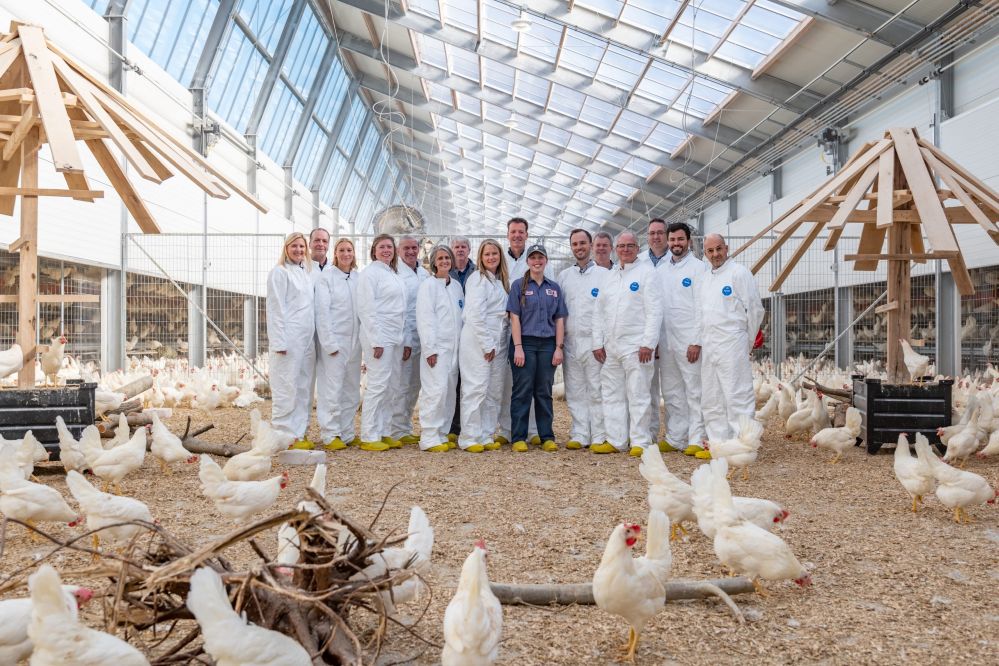Dutch egg producer Kipster has become the second firm in the US (following Egg Innovations) to commit to implementing in-ovo sexing as an alternative to culling male chicks.
Kipster—which operates three egg farms in the Netherlands and is planning new facilities in the UK and France—entered the US market in late 2022 via a partnership with MPS Egg Farms and Kroger, which sells Kipster’s certified humane and carbon neutral eggs under its Simple Truth brand.
The in ovo sexing technology—which will enable Kipster to determine the sex of chicks well before they hatch—will be implemented in the fall at the company’s facility in Indiana, cofounder Ruud Zanders told AgFunderNews.
“Our goal is that in October, the next flock is coming and then we are fully committed to in ovo sexing.”
Kipster is not yet disclosing which company it is partnering with, but said it will be using so-called allantoic sampling, whereby a drop of liquid is extracted from eggs at around day nine of incubation and tested for biomarkers that can be used to determine the sex of the egg.
This is a high-throughput approach already commercialized in Europe through the Respeggt brand deploying technology from In Ovo, PLANTegg and Seleggt and highlighted on eggs sold in leading retailers including Carrefour, Rewe, and Edeka.
It is generally more expensive than non-invasive imaging (see below), but can work earlier on in the incubation period.
Why are male chicks culled at birth?
While the egg industry has been trying to find solutions for years, many consumers are unaware that it slaughters billions of male chicks every year… but not to put meat on the table.
Right now, most US hatcheries incubate billions of eggs, wait 21 days for them to hatch, hire trained ‘sexers’ to determine their sex, and then cull 50% of their chicks (via suffocation or grinding) because the males are of no use to the food industry. They can’t lay eggs, and there’s no market for their meat, as the breeds of chicken used in the egg and meat industries are different.
Kipster has been raising males in Europe for meat via a partnership with Lidl, but says there is no market for rooster meat in the US.
According to Zanders: “There are multiple challenges. First, there’s no infrastructure for slaughtering the roosters in the US, just as there is no infrastructure for slaughtering spent hens [former egg-laying chickens] for the [human] food market, so many companies kill them at the farm and they go to landfill. The other issue is that the meat tastes different, and while it’s actually very good—and what our grandparents used to eat—people are used to the taste of broiler chickens now, so there just isn’t a market for rooster meat here [in the US].”
He added: “Our first five flocks we did in the US, we reared the male chicks, but we couldn’t make it work, so for the latest flocks we’ve had to kill them at day one. This [in ovo sexing] technology will enable us to continue our commitment to animal welfare and zero waste.”
The male eggs diverted from the hatcheries after sexing can be used in various industries including animal feed, according to Kipster, which feeds its chickens with primarily waste food rather than grains, powers its barns using solar energy, and raises its chickens in conditions certified humane by Humane Farm Animal Care.
“Each year, at just one day old, billions of male chicks are killed without a second thought—deemed a “by-product” by the egg industry. With alternative methods available, we’re eager to see male chick culling come to an end once and for all.” Giovana Vieira, senior animal welfare scientist, The Humane League

In ovo sexing: gaining traction in Europe… slower progress in the US
Research from US nonprofit Innovate Animal Ag (IAA) suggests that in-ovo sexing achieved market penetration of almost 15% in the EU by last fall, although it has yet to gain traction in the US.
In Europe, regulatory interventions have spurred the industry into action, with Germany, France and Austria (with some exceptions) banning the culling of male chicks and Italy planning to phase it out by 2026. There has also been some activity in other markets without such regulations, notably Norway, with leading hatchery Steinsland & Co recently installing in-ovo sexing technology from Respeggt.

The path to commercialization in the US
US producers, who are not under pressure from government to end the practice of culling male chicks, have been slower to engage, with little incentive for companies to invest in solving a problem that 89% of Americans do not know exists, according to survey data from Innovate Animal Ag.
United Egg Producers (UEP), which accounts for 90% of US egg production, called for the elimination of day-old male chick culling in 2016 but issued a statement five years later arguing that “a method that meets the food safety, ethical standards and scalable solutions needed for the United States is not yet available.”
According to organizers of the Egg-Tech Prize, a global competition to find high-tech solutions to end male chick culling, none of the finalists has yet been able to meet all the criteria, which include strict thresholds on speed/throughput (15,000 eggs/hour) and accuracy (98%+ at day eight or earlier) to create a “a scalable, commercially viable solution to male chick culling worldwide.”

Egg Innovations commits to in ovo sexing
However, some US companies are now taking the plunge, with free-range and pasture-raised egg producer Egg Innovations recently committing to implementing in-ovo sexing technology although it did not give a timeframe.
While mainstream egg producers may be watching and waiting for now, the “path to commercialization in the US starts at the high end of the market where consumers have shown they are willing to pay a price for higher quality, higher welfare organic or pasture-raised eggs,” IAA founder and CEO Robert Yaman told AgFunderNews in a recent interview.
And while current in-ovo sexing approaches add between 1-3 cents per egg to the retail price, the cost will go down over time, to the point where there is no cost once you factor in the savings from freeing up incubator space and not paying people to sex chicks, claimed Zanders at Kipster.
“I don’t agree that US consumers care less about animal welfare and won’t pay. I think it’s partly because they don’t know what is happening to these [male] chicks. I also think that over time, costs will come down.”

Sex determination techniques
Currently, in-ovo sex determination technologies can be grouped into six buckets, says Innovate Animal Ag:
1) Non-Invasive Imaging (already on the market): Looking through the shell of an egg to determine the sex of the embryo inside.
German firm Agri Advanced Technologies (AAT) — which has machines in seven hatcheries in six countries — uses hyperspectral imaging to determine the color of the embryo’s feathers, which can sex eggs of brown layers, since males and females have different colored feathers.
Fellow German firm Orbem, meanwhile, combines AI with MRI (magnetic resonance imaging), to examine the organ development of embryos to detect physical differences between the males and females without penetrating the shell, and can work with brown and white layers.
Omegga, another German startup, is developing a non-invasive technology where an imaging machine is installed directly inside the incubator to capture spectroscopic images over the course of several days, potentially working much earlier in the development process and eliminating the need to remove eggs from the incubator to be sexed.
While non-invasive imaging is fast, simple, and cheap, says Innovate Animal Ag, the downside is that for the commercialized tech at least, you must wait until a relatively late stage in the embryo’s incubation (12 days) to ensure accuracy.
However, a study indicating that chicken embryos can’t feel pain before day 13 of incubation has prompted the German government to amend its legislation* on male chick culling to allow for in-ovo sexing up to and including day 12, which would permit imaging techniques such as those deployed by AAT and Orbem when the legislation comes into full force in January 2024.
*The German ban on male chick culling originally required producers to sex chicks by day six of incubation although no commercialized technology could determine the sex of an egg that early.
2) Allantoic sampling (already on the market): Extracting a drop of liquid from eggs around day nine of incubation and testing it for biomarkers that enable it to sex the egg.
This is a high-throughput approach currently commercialized in Europe through the Respeggt brand deploying technology from In Ovo, PLANTegg and Seleggt and highlighted on eggs sold in leading retailers including Carrefour, Rewe, and Edeka.
It is generally more expensive than non-invasive imaging, but can work earlier on in the incubation period.
3) Genetic editing: Using gene editing to give male embryos a genetic marker that allows them to be easily identified (eggXYt), or to stop growing entirely (Huminn). Only the males carry the genetic trait, so females and the eggs that make it into the supply are not genetically modified.
While any approach using genetic engineering can present regulatory or consumer challenges, it enables non-invasive, rapid sex detection before eggs enter the incubation process, whereas most other approaches are only viable several days into the incubation process.
4) Volatile analysis: Detecting sex-specific volatiles that escape through the eggshell.
5) Spectroscopic imaging: Taking images of embryos via tiny holes in the shell. This is more complex and expensive than non-invasive imaging but can be effective at an earlier stage of incubation, claims Innovate Animal Ag.
6) Sex reversal: Israeli firm SOOS Technology is exploring techniques including changing humidity, temperature, and sound vibrations to switch the sex of embryos from male to female, which if validated, would be an exciting solution, although the technique is still in its infancy.




